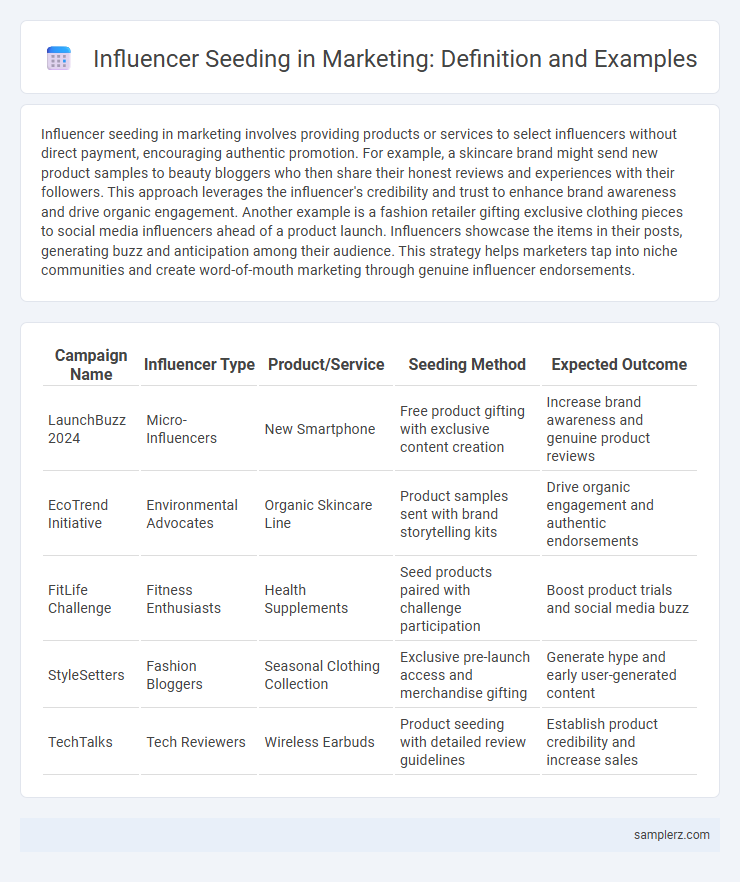Influencer seeding in marketing involves providing products or services to select influencers without direct payment, encouraging authentic promotion. For example, a skincare brand might send new product samples to beauty bloggers who then share their honest reviews and experiences with their followers. This approach leverages the influencer's credibility and trust to enhance brand awareness and drive organic engagement. Another example is a fashion retailer gifting exclusive clothing pieces to social media influencers ahead of a product launch. Influencers showcase the items in their posts, generating buzz and anticipation among their audience. This strategy helps marketers tap into niche communities and create word-of-mouth marketing through genuine influencer endorsements.
Table of Comparison
| Campaign Name | Influencer Type | Product/Service | Seeding Method | Expected Outcome |
|---|---|---|---|---|
| LaunchBuzz 2024 | Micro-Influencers | New Smartphone | Free product gifting with exclusive content creation | Increase brand awareness and genuine product reviews |
| EcoTrend Initiative | Environmental Advocates | Organic Skincare Line | Product samples sent with brand storytelling kits | Drive organic engagement and authentic endorsements |
| FitLife Challenge | Fitness Enthusiasts | Health Supplements | Seed products paired with challenge participation | Boost product trials and social media buzz |
| StyleSetters | Fashion Bloggers | Seasonal Clothing Collection | Exclusive pre-launch access and merchandise gifting | Generate hype and early user-generated content |
| TechTalks | Tech Reviewers | Wireless Earbuds | Product seeding with detailed review guidelines | Establish product credibility and increase sales |
Understanding Influencer Seeding in Marketing
Influencer seeding in marketing involves strategically providing products or services to select influencers to generate authentic content and spark organic conversations around a brand. This approach leverages micro and macro influencers with targeted audiences to amplify brand visibility and foster trust through genuine endorsements. Measuring engagement metrics such as likes, shares, and comments helps evaluate the campaign's impact and ROI.
Key Benefits of Influencer Seeding Campaigns
Influencer seeding campaigns in marketing boost brand awareness by authentically integrating products into influencers' content, increasing organic reach and engagement. These campaigns generate high-quality user-generated content that enhances social proof and trust among target audiences. Cost-effective compared to traditional advertising, influencer seeding also fosters long-term relationships, driving sustained brand loyalty and conversion rates.
How Influencer Seeding Differs from Traditional Sponsorships
Influencer seeding involves providing products to select influencers without a formal contract, encouraging authentic and organic promotion, unlike traditional sponsorships that require structured agreements and paid endorsements. This approach leverages trust and genuine user experiences, resulting in higher engagement and credibility among target audiences. Influencer seeding emphasizes personalization and relationship-building, creating long-term brand advocates rather than one-time advertisements.
Notable Influencer Seeding Success Stories
Nike's collaboration with influential athletes such as Serena Williams exemplifies successful influencer seeding, amplifying brand visibility through authentic endorsements. Glossier leveraged micro-influencers by sending personalized product packages, generating organic buzz and user-generated content across social media platforms. Daniel Wellington's strategic gifting of watches to fashion bloggers resulted in a significant increase in global brand awareness and sales, showcasing the power of targeted influencer seeding campaigns.
Example 1: Beauty Brands and Micro-Influencers
Beauty brands utilize influencer seeding by sending free product samples to micro-influencers with highly engaged niche audiences, driving authentic word-of-mouth promotion. These collaborations often result in organic social media posts showcasing product use, enhancing brand visibility and credibility. Micro-influencers' targeted reach helps beauty brands effectively convert potential customers through trusted recommendations and real-life testimonials.
Example 2: Tech Startups Leveraging Unboxing Videos
Tech startups often leverage influencer seeding by sending new gadgets to tech reviewers for unboxing videos that showcase product features and user experience. These videos generate authentic buzz and build trust within niche tech communities, driving early adoption. Brands track engagement metrics such as views, likes, and comments to measure campaign effectiveness and optimize future seeding strategies.
Example 3: Fashion Labels Partnering with Lifestyle Bloggers
Fashion labels leverage influencer seeding by partnering with lifestyle bloggers who showcase their apparel in authentic, everyday settings, driving organic brand awareness among target demographics. These collaborations often involve gifting exclusive collections or early product releases, encouraging bloggers to create styled content that resonates with their engaged followers. This strategy enhances brand credibility and boosts conversion rates as the bloggers' trusted recommendations inspire purchasing decisions.
Example 4: Fitness Brands and Authentic Product Sharing
Fitness brands use influencer seeding by gifting products like workout apparel or supplements to athletes and fitness enthusiasts who authentically share their experiences on social media. When influencers post genuine reviews and demonstrate real results, it increases brand credibility and attracts health-conscious consumers. This strategy leverages trust and community engagement to boost brand visibility and sales in the competitive fitness market.
How to Measure Success in Influencer Seeding
Measuring success in influencer seeding involves tracking key performance indicators such as engagement rates, including likes, comments, and shares on influencer-generated content. Monitoring referral traffic and conversion rates from influencer links provides insight into direct ROI and campaign effectiveness. Utilizing tools like unique discount codes and affiliate tracking helps quantify influencer impact on sales and brand awareness.
Best Practices for Effective Influencer Seeding Campaigns
Successful influencer seeding campaigns target influencers whose audience aligns closely with the brand's ideal customer profile, ensuring authentic engagement and higher conversion rates. Providing influencers with personalized, high-quality products or exclusive experiences enhances their motivation to share genuine content that resonates with their followers. Tracking key performance indicators such as engagement rate, reach, and conversion metrics enables continuous optimization and maximizes the campaign's overall impact.

example of influencer seeding in marketing Infographic
 samplerz.com
samplerz.com